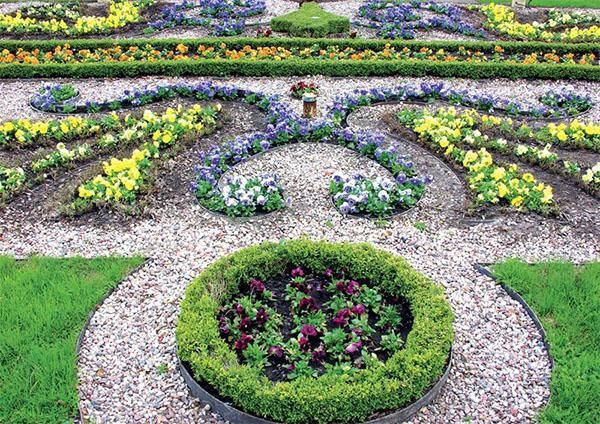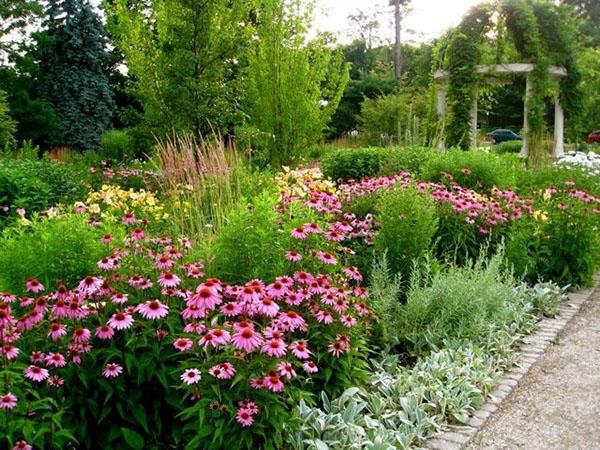How to make a mixborder with your own hands at their summer cottage

Luxurious flower gardens, consisting of perennials, are considered the most popular element of landscape design. Therefore, many want to figure out how to make a mixborder with their own hands in order to keep up with fashion. Everyone, even a novice gardener, can comprehend the art of harmoniously combining plants. You just need to heed the advice of experts.
Meet - an oasis of pleasure on the site

True admirers of flora everywhere create unique landscapes from various types of plants. But for beginners, it remains a mystery what a mixborder is, since the word has a foreign origin. Translated into Russian, it means "mixed border" or "border".
It is an original mixed flower bed, which consists of crops:
- various annual and perennial flowers;
- potted plants;
- decorative shrubs;
- coniferous and low deciduous trees;
- some cereals.
The width of the site is usually 2 times the tallest plant, which is located at the extreme border. Therefore, mixborders come in different shapes and sizes.
They equip an "oasis of pleasure" both inside the suburban area and on the outskirts. It often decorates:
- garden alleys;
- lawns;
- front entrance;
- artificial reservoirs;
- outdoor stairs of residential buildings.

Although from the outside, it seems that the plants are planted randomly, each of them occupies a special place and requires competent care, which includes:
- moderate watering;
- planned pruning;
- regular feeding;
- protection from pests;
- disease prevention;
- timely transplant.
Perhaps someone will be frightened by such a list of works. However, knowing how to make a mixborder with your own hands encourages greenery lovers to get down to business immediately. Many have managed to create a luxurious corner from the original composition of plants at their summer cottage.
When choosing suitable crops, you should consider their expected size and flowering time.
How to make a mixborder with your own hands: choosing a suitable territory

The first step towards creating a gorgeous flower garden is to select a site. After all, various types of cultures will "settle" on it, which require special conditions. Therefore, it is best to avoid extremes. What will a flower bed turn into under the scorching sun or in a damp shaded area? The answer is obvious. Conditions for the successful flourishing of plants must be neutral: moderate light and humidity.
It is important to think about where to equip the future mixborder:
- next to the facade of a residential building;
- on the border of a cozy terrace;
- along the borders of garden alleys;
- against the background of green lawns;
- use as a flower fence.
Interestingly, such flower beds can be of completely different sizes. This makes it possible to wisely distribute some plants in the sun and others in partial shade.
In addition, for the successful creation of mixborders, its shape should also be taken into account, which can be in the form:
- circle;
- triangle;
- square;
- an elongated rectangle;
- curving brook.
When a suitable site has already been selected, they begin to prepare it. It includes deep loosening of the soil, weed removal and top dressing.
On spacious mixborders, it is necessary to leave space in advance for a narrow path. This will help you take good care of your plants.
The key to success is planting principles

Unlike conventional flower beds, mixborders are made up of plants that grow in small groups. Each of them smoothly passes into one another, especially during the flowering period. An important element of the flower bed are "skeletal" crops: trees, shrubs, perennials. They are the main parts of the whole composition, even in the cold season.
For this purpose, use:
- cypress;
- conical spruce;
- dwarf pine;
- columnar yew;
- scaly juniper;
- weeping larch;
- viburnum;
- elderberry;
- jasmine;
- lilac;
- fir;
- thuyu.
Such plants for mixborders are planted at a certain distance from each other in order to maintain the integrity of the garden. They are pruned every year to rejuvenate, thin out and extend the flowering period. In addition, plants with different flowering periods are widely used to create a mixed flower bed. Thanks to this, it will shine with bright colors in early spring. Will give lush bouquets in hot summer. Will delight you with the farewell lights of the outgoing autumn.
If you place perennials in groups, their periodic flowering gives the flower bed a special flavor.
When choosing crops, it is important to consider the type of soil, lighting and the degree of moisture. Interestingly, even in winter, the mixborder has a gorgeous look. Dried perennial grasses look wonderful against the backdrop of a snow-white landscape and coniferous bushes.
Simple scheme for the selection of plants

Consider how in practice you can create a mixborder step by step from perennials. First of all, we select suitable crops with different flowering periods.

For example, let's take a universal version of a flower bed that includes popular perennials:
- Geranium "Endressa" (frost-resistant, blooms almost all summer).
- "Cuff" (herbaceous culture with miniature yellow buds).
- Geranium "Majestic" (plays with brick-red paints for about 40 days).
- Coreopsis whorled. It blooms with yellow buds with a lilac, brownish or pink tint.
- Shrub cinquefoil. Inflorescences appear in July and remain until the end of August. In the fall, the leaves don a yellow outfit, attracting everyone's attention.
- Yarrow. Pleasing to the eye until the beginning of autumn.
- Decorative bow. The plant brings some refreshment and charm to the landscape. Although it blooms in late spring, the fluffy balls persist until the very end of autumn.
- Fennel multi-grate. Corolla inflorescences are colored dark purple. The culture reaches 1 m in height.
- Bonar verbena. This elegant flower is studded with many purple stars. They persist until the first autumn frosts.
- Boxwood. The undersized shrub grows very slowly, but is considered the magnificent green crown of the mixborder.
- Decorative wormwood. Its lacy foliage emphasizes the uniqueness of the mixed flower garden.
- Lofant. The plant is capable of blooming until late autumn. It grows quickly and looks spectacular on the back of the flower bed.
- Echinacea purpurea. An upright flower is placed among lush plantings to give it a presentable look.
- Shrub "Khatma". Will grow to about 2 m in height and bloom profusely before winter begins.
- Clematis. Differs in delicate buds of white, blue, red, pink. Flowering stops when persistent frosts appear.
Such a mixborder planting scheme will help you select and plant plants in a flower bed. At the same time, it is important to take into account the needs of each crop regarding soil acidity, lighting and the amount of moisture.

There are various mixed flower bed schemes that include conifers, fruit trees, and annual flowers.
A creative approach to arranging a flower bed

True fans of flora dream of creating not just a banal flower garden on the site. They want to get creative, including wild imagination. Therefore, the design and fit of mixborders brings them real satisfaction.
These can be compositions:
- bright planting against the backdrop of lawn greenery;
- an elongated lawn along low-growing bushes;
- a fruit tree surrounded by a periwinkle or marigold rug.
Lovers of the classics can create a mixborder in the English style. According to the generally accepted scheme, it includes:
- stonecrop;
- park roses;
- verbena;
- rosemary;
- sagebrush;
- yarrow;
- sage.
The composition is decorated with foxglove, camomiles, tall bells, delphinium. Primroses, carnations, daisies, violets are planted around the edges. In general, the mixed flower bed will shine with all sorts of shades of yellow, scarlet and orange.

An original solution to how to make a mixborder with your own hands may be the idea of planting plants along the fence. The width of the composition usually does not exceed 1.5 m, so that it is convenient to plant new crops.
They will find their place here:
- ferns;
- geycher;
- daylilies;
- crocuses;
- hyacinths;
- tulips;
- daffodils;
- pansies;
- petunias;
- zinnias.
Of course, before planting a mixborder, a diagram is drawn up on which the location of the plants is marked. This takes into account the "skeletal" cultures, such as undersized shrubs, conifers and fruit trees. In addition, it is advisable to plant perennials tightly in order to get a beautiful composition of flowers. And then a luxurious oasis for enjoyment will appear in the country.